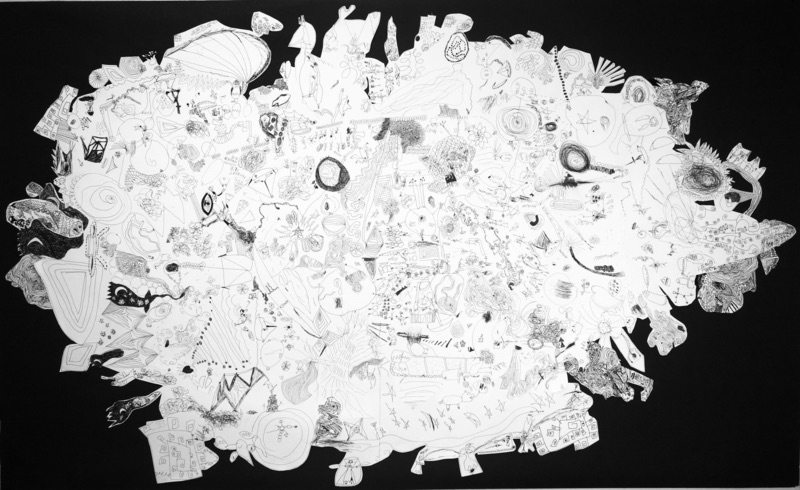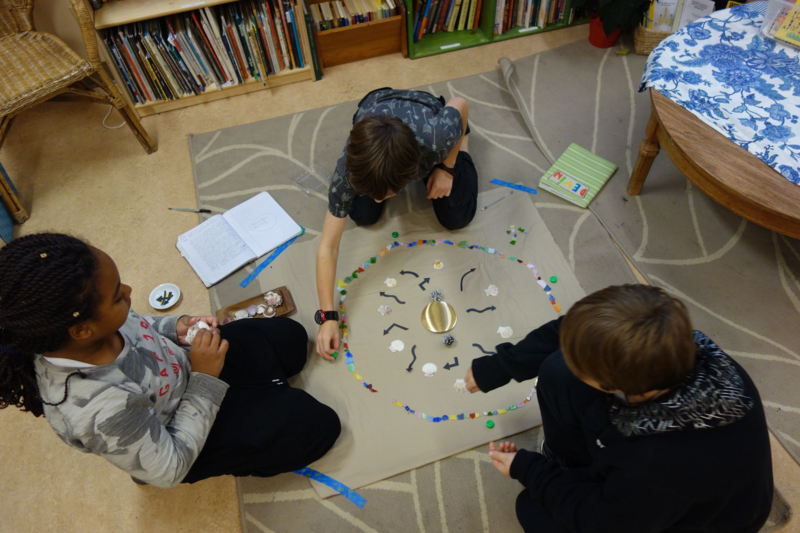Where do you get your professional development?

Magnolia Room (Grades 1-2) whole class doodle. “It’s like an idea seed…”
The question comes up, at some point, during almost every study tour. A visiting educator will ask: Where do Opal School teachers get their professional development?
I understand why the question is asked with such regularity. The question poser came to Opal School to support her inquiry into her practice. Budget constraints mean that Opal School teachers don’t have the benefit of traveling to similar professional development retreats (though if any funders are reading this, let’s talk!) So: what supports their growth?
Professional development is fundamentally embedded into the work of teacher-researchers. Opal School teachers listen closely to what is happening in the classrooms and reflect – individually and collaboratively – on their observations in order to make sense of what is happening and identify possibilities for what might come next. We’re always sharing our theories – with each other, with the children, and with the outside world.
Structurally, we meet weekly as a full staff. In order to avoid the pratfalls that afflict so many such gatherings, we make an effort to use our time together to reflect on our experiences and construct new understandings. Inquiry protocols help us pursue this intention.
For the last month, our meetings have been built around two such structures: one, guiding emerging project work; the other, around classroom environments. Some of the teachers thought the experience might be of interest to blog readers.
Project Work Clarifying Protocol
Developing project work is an elaborate dance that unfolds across the school year. Often described using the metaphor of a “ball toss”, teachers carefully observe children to see how their interests, curiosities, and passions might connect with overarching curricular ideas, questions, and resources. Because this looks different every year and with every group, it both avoids dreadful predetermination and demands a willingness to wade in uncertain waters. At times, the waves get big and it can be hard to tell where the current is taking you. One life raft we’ve identified is a clarifying protocol.
All protocols have a clear order for contributions. Here, we use the following:
- Provocation: Opening the box (5 minutes) The presenting teacher shares what is happening in her classroom. This isn’t a scripted delivery – there is a lot of “think-talking” here. What is she observing? What are children doing? What actions has she taken? What seems important? What is she wondering about? As she presents, the rest of the group silently listens and records what she is saying.
- Reflecting Back: Making thinking visible (5 minutes) Participants take turns saying what they heard verbatim – without interpreting, critiquing, or making suggestions. The presenting teacher silently listens and takes notes during this time.
- Wonderings: Clarifying and investigating (5 minutes) Participants take turns asking questions about what the presenter shared without interpreting, critiquing or making suggestions. The presenting teacher silently listens and takes notes during this time.
- Responding to Questions: Going deeper (5 minutes) Without interruption, the presenting teacher selects several questions that she would like to respond to. These questions might be ones which requested greater clarity, led to rethinking previous ideas, or in other ways stimulated deeper inquiry.
- Speculations: Opening doors wider (5 minutes) Members of the group offer theories about what might be going on and related possibilities – based in their unique perspectives. This is a time of open conversation.
Investigating Environments
The second half of our gatherings has been spent investigating classroom environments. The idea that the environment is a teacher is one of Opal School’s Guiding Principles. Providing time to explore each classroom environment allows that teaching to influence all of us.
In this case, we start with a block of time (at least 15 minutes) of silently exploring a classroom environment. Questions that teachers might think about include: What does this environment say to – and about – the children and adults who live there? How is playful inquiry supported in the organization and documentation? How are children’s ideas made visible? What kinds of invitations are present? What do you notice? What do you wonder about?
After time spent exploring and taking notes, we gather back together and share ideas provoked by the environment that we want to continue thinking about when we return to our classrooms. The focus is to stay out of advocacy and evaluation (I really like how you…) and instead remain in inquiry (What am I wondering about? How am I feeling inspired? What do I want to think more about?)
All the teachers – whether the ones presenting problems, those whose classrooms are being investigated, or their colleagues – have expressed appreciation for how these structures expose and begin to untangle the complicated knots of co-created curriculum and expose the conditions that foster creativity, curiosity, and the wonder of learning. Readers searching for more protocols that support a staff to live in inquiry might look to the National School Reform Faculty, School Reform Initiative, and Looking at Student Work.
I’m curious: How does your staff community support each other to stay in inquiry?


After I wrote this post, I came across this passage in Ta-Nehisi Coates’ Between the World and Me:
“Why, precisely, was I sitting in this classroom?
The question was never answered. I was a curious boy, bu the schools were not concerned with curiosity. They were concerned with compliance.”
Let’s commit our schools to fostering curiosity – not compliance – in children and adults alike.
Thanks so much for this window into your practice. As a professional development provider this is something I needed to see this week. With Gratitude.